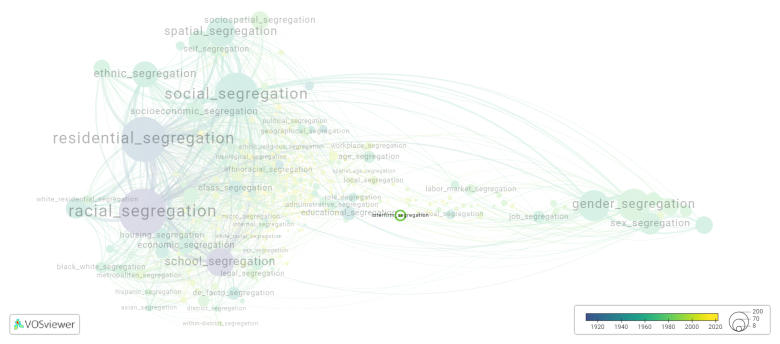Interfirm segregation: Difference between revisions
(Creating page) |
(Creating page) |
||
| Line 22: | Line 22: | ||
[[File:interfirm_segregation.png|780x780px]] | [[File:interfirm_segregation.png|780x780px]] | ||
This visualization is based on the study [[How_to_cite_Segregation_Wiki| The Multidisciplinary Landscape of Segregation Research]]. | |||
For the complete network of | For the complete network of interrelated segregation forms, please refer to: | ||
* | * [https://tinyurl.com/2235lkhw First year of publication] | ||
* | * [https://tinyurl.com/2d8wg5n3 Louvain clusters] | ||
* | * [https://tinyurl.com/223udk5r Betweenness centrality] | ||
* | * [https://tinyurl.com/244d8unz Disciplines in which segregation forms first emerged (Scopus database).] | ||
==References== | ==References== | ||
==Notes== | ==Notes== | ||
Revision as of 07:48, 10 October 2024
Date and country of first publication[1]
1995
United States
Definition
Interfirm segregation refers to the separation and division of firms based on various factors such as industry, market segment, or geographic location. It is a phenomenon where firms with similar characteristics tend to cluster together.
There are several reasons why interfirm segregation occurs. One reason is the need for collaboration and knowledge sharing within the same industry. Firms that operate in the same industry tend to face similar challenges and can benefit from sharing information and resources.
Another reason for interfirm segregation is market differentiation. Firms may specialize in specific market segments or target different customer groups, leading to segregation based on their target markets.
Geographic location is also a factor contributing to interfirm segregation. Firms often cluster together in specific regions or cities due to factors such as proximity to suppliers or customers, access to skilled labor, or regional industry specialization.
Interfirm segregation can have both positive and negative consequences. On the positive side, it can foster collaboration and innovation within the industry, promote competition, and create economies of scale. On the negative side, it can lead to information asymmetry, limited access to resources for firms outside the cluster, and reduced competition in the local market.
To overcome the negative effects of interfirm segregation, policymakers and industry stakeholders can promote cross-industry collaboration, encourage knowledge sharing and networking among firms, and provide support to firms located outside major clusters.
See also
Related segregation forms
Interfirm segregation is frequently discussed in the literature with the following segregation forms:
gender segregation, occupational segregation, interfirm gender segregation, neighborhood segregation, role segregation

This visualization is based on the study The Multidisciplinary Landscape of Segregation Research.
For the complete network of interrelated segregation forms, please refer to:
References
Notes
- ↑ Date and country of first publication as informed by the Scopus database (December 2023).
At its current state, this definition has been generated by a Large Language Model (LLM) so far without review by an independent researcher or a member of the curating team of segregation experts that keep the Segregation Wiki online. While we strive for accuracy, we cannot guarantee its reliability, completeness and timeliness. Please use this content with caution and verify information as needed. Also, feel free to improve on the definition as you see fit, including the use of references and other informational resources. We value your input in enhancing the quality and accuracy of the definitions of segregation forms collectively offered in the Segregation Wiki ©.
Interfirm segregation appears in the following literature
Carrington W.J., Troske K.R. (1995). Gender segregation in small firms. Journal of Human Resources, 30(3), 503-533. https://doi.org/10.2307/146033
Carrington W.J., Troske K.R. (1998). Interfirm segregation and the black/white wage gap. Journal of Labor Economics, 16(2), 231-260. University of Chicago Press.https://doi.org/10.1086/209888
Müller T., Ramirez J. (2009). Wage inequality and segregation between native and immigrant workers in Switzerland: Evidence using matched employee employer data. Research on Economic Inequality, 17(), 205-243. https://doi.org/10.1108/S1049-2585(2009)0000017014
